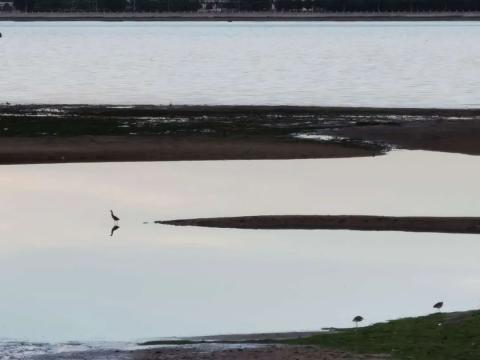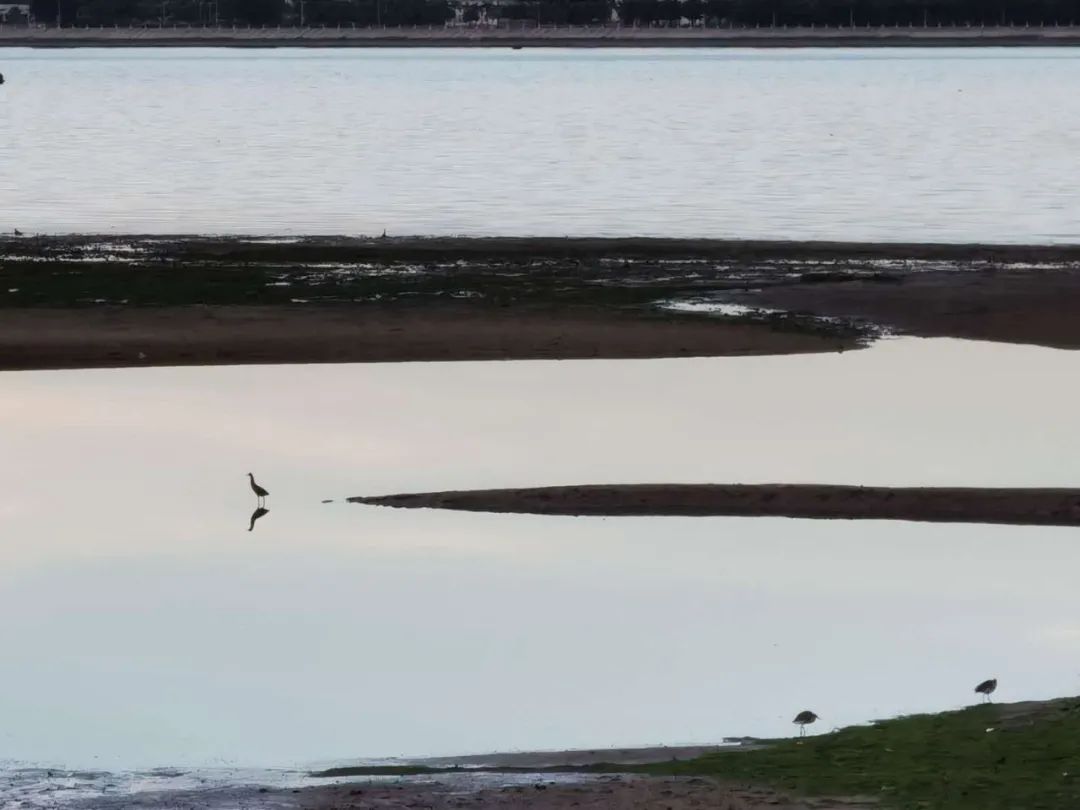

I went to Zhanjiang this summer, which was the shortest trip ever with my daughter on a summer vacation. But this time, I felt it was as good as any other trip in the past. Perhaps because I have established relationships with more people, I wanted to write a travelogue for the first time.
When I first arrived on Friday night, almost all my friends from Zhanjiang came to get together. We had a very sumptuous meal with many dishes at the Golden Bauhinia Restaurant in the south of Haibin Avenue in Xiashan District. But I only remembered to eat and completely forgot to take pictures. All in all, it is very delicious. Please imagine, this is the best seafood production area in Guangdong~a sumptuous seafood banquet, a table full of seafood~~~

That night, I learned about the history of Zhanjiang from my friends. After the Japanese occupation of Hong Kong and the fall of Hong Kong, Guangzhou Bay, where Zhanjiang is located, replaced the Pearl River Delta estuary and became the country's only sea port. It was a French colony at the time, and it was once glorious. . During the Japanese occupation, a large number of cultural figures and businessmen moved from Hong Kong to Zhanjiang, and industry also moved to Zhanjiang. Therefore, in the early days of the founding of the People's Republic of China, Zhanjiang's industrial base was second only to Guangzhou in Guangdong Province, and it also had three universities. The medical school here is actually named Guangdong Medical College, probably due to the accumulation during that period.
I remember when I went to Naozhou Island four years ago, I heard the locals say that Naozhou Island is a little Hong Kong. I didn’t take it seriously at the time, thinking it was something people who love their hometown often say. Only when I came to Zhanjiang this time did I slowly understand that, This is not an exaggeration, this is a plain description: the glory of the past is real.
After the founding of the People's Republic of China, the South China Sea Fleet was stationed in Zhanjiang, and transportation was inconvenient. Zhanjiang's development has not been very good. However, it is one of the few places in Guangdong Province besides Guangzhou City that has three serious universities. After these years of extensive construction, we can already see the scale of a big city, which is completely different from the remote fifth-tier cities I imagined in the past.

The next day, my friend took me to Chikan Old Street and had an authentic breakfast.
The name of the old restaurant is "Rongshuwan Food Court" or "Da Rongshu Food ", the former is dinner and the latter is breakfast.
The signature delicacy of breakfast is the fried dough sticks, which are more solid and taste better than the fried dough sticks found in other places. I watched other people eating beef brisket noodles in the store, so I couldn't help but order another beef brisket noodles. As a result, my friend ordered beef fried noodles, a cup of soy milk for each person, a daylily and pork liver soup, and One seafood porridge, and the whole group was so full that they leaned against the wall and walked out.

Then, my friend drove me to Chikan Old Street. Chikan Old Street is the filming location of "The Hidden Corner". It is an old street selected by the director team after a long time of running around, showing the old houses and old street scenes of the seaside town in the 1980s and 1990s.
The shop where we had breakfast was relocated from the well. The day we went there, we still saw people putting bowls on the edge of the well to have breakfast.
Zhanjiang's economic development has indeed been somewhat slow in recent years. There has been no large-scale demolition and construction of real estate in the old city, and a large number of old houses and old street scenes have been preserved, so the crew chose this place as the filming location.

There is a small shop selling hookah pipes on Chikan Old Street. There are piles of bamboo hookah pipes all over the floor. There are exquisitely decorated and beautiful luxurious versions, there are also simple versions with only polished exterior and exposed bamboo texture, and there are also whole boxes. A whole box of shisha tobacco.
I'm very curious. Except for the ethnic minority areas in Yunnan and Guizhou, you can hardly see hookahs like this in other cities. Do people still use this here? A friend said that hookah pipes like this are quite common in Zhanjiang. There are people in their office who use hookah pipes like this. They make a snoring sound and are very powerful when inhaled.

There was a family on the roadside holding four or five kittens with ropes, as well as a mother cat. I asked if they were selling kittens. The kitten is very afraid of people and hides away from people. The mother cat is very clingy. My daughter and I played with the cat there for a while, and the mother cat walked around me, begging to be petted.
Then I came across two museums, both of which are free and you can enter with a signature. One is called Mingde Art Museum and the other is Guangzhou Bay History and Folklore Museum, which records the history of Guangzhou Bay.
The Mingde Art Museum has an exhibition of ancient coins, a collection of old building materials such as tile plaques, old photos, wood carvings, etc. The decoration is very exquisite. It can be seen that it was an old house of a wealthy family in the past. There is also a European-style small on the roof. patio.
The Guangzhou Bay Historical and Folk Museum has a wide range of contents, including food, clothing, housing, transportation, mahjong, billiards, barber chairs, hairpins, clothing, business supplies, opium cigarette supplies, foreign trade goods, oil lamps, glass decorations, furniture, etc. of that era, and some Historical data introduces the migration of cultural figures to Guangzhou Bay during the Anti-Japanese War.
In recent years, the country has spent a lot of manpower and material resources on cultural promotion, which is indeed necessary. Otherwise, I simply cannot understand why a small Zhanjiang, such a remote city, has such a good medical school. It's called Guangdong Medical University, while the one in Guangzhou is just called Guangzhou Medical College, and there are actually three universities in this city: Guangdong Medical University, Guangdong Ocean University, and Lingnan Normal College.

Then my friend pointed me to Guangzhou Bay Pier 1-8, which looked like a flight of stairs. Due to reclamation, the pier that extended into the sea has now become an ordinary-looking staircase. If someone hadn't pointed it out, I wouldn't have known that the stairs in the middle of such a dilapidated house were actually the dock of the famous Guangzhou Bay.
What's special is that there is a very special building next to Pier 1. It has the words "Mainxiong Hall" written on it. When I look at it from left to right, it looks like an ordinary private house. However, these words cannot appear in it. It was on a private house, so I took a closer look and found that it was indeed a temple. It was truly an extraordinary temple~
We looked at the piers in turn, as well as the old houses near the piers. There were still people living in them, and there were also children's toys and fitness facilities.
The mottled walls and dilapidated houses are the memories of an old city.

The place to eat at noon is "Yue Baihai" in the Leshan branch. This shop doesn't look like anything special, but the crabs eaten in this shop are the best crabs I have ever eaten in my life. The desserts and pastries after the meal are also very good, but it’s a pity that I just patronized it and there are no photos. Please continue to drool and imagine~~
After eating, it was the hottest time of the day, so we went back to our room to sleep. I woke up and heard thunder outside, so I canceled my plan to go to Huguangyan and went directly to have dinner.
This is simply the rhythm of eating and sleeping, sleeping and eating. It’s so sinful~
Fortunately, the place where we ate in the evening was called Sea Coral. If we didn’t book a room in advance, there were no vacancies. So we went to the sea view promenade first to see the mangroves and coastal beaches. It was also an afternoon exercise.
It is said that this area was originally dirty, messy, and smelly. It was an area where urban sewage was discharged, and the mangroves were cut down. In recent years, it has been better managed, mangroves have been replanted, egrets and other birds have begun to live there, and the environment has gradually become much better.
There are many crabs and water birds on the beach below the promenade. It was very beautiful at sunset. I took a lot of photos here, including some of birds flying on the water, which really created a good mood.

After the sun went down, we went to Sea Coral Restaurant.
There is a large room right at the entrance. There are about a dozen large tanks containing corals, stingrays, garden eels and other marine life for diners to visit. There are so many corals of different shapes, and there are also cute fish, like stingrays hanging on the rocks like a piece of cloth without bones, and garden eels burrowing between jars and rocks. It’s so fun, look at it. I don’t even want to go to eat~
There are still no photos of seafood, but there are many photos of coral stingrays, garden eels~~

A little history refresher:
Zhanjiang, which has a long history, is the largest city in western Guangdong. It was formerly known as Guangzhou Bay and was formerly a French concession (colony). The name "Guangzhou Bay" was formed during the Qing Dynasty and has little connection with today's Guangzhou City.
In 1899, the current central urban area of Zhanjiang was "leased" by France, and it was named "Guangzhou Bay" at that time. The French took advantage of this excellent deep-water port to occupy Leizhou Peninsula and Hainan Island, and stayed here for 45 years. The French buildings in Chikan District and Xiashan District and the lighthouse on Naozhou Island are relics from that period.
Mr. Wen Yiduo wrote the famous "Song of the Seven Sons", comparing the seven "lost territories" of our country that were plundered by the foreign powers at that time, including Macau, Hong Kong, Taiwan, Weihaiwei, Guangzhou Bay, Kowloon, Lushun, and Dalian, to being far away. The mother's seven children, of which Chapter 5 is Guangzhou Bay.
After the outbreak of the Anti-Japanese War in 1937, coastal ports fell one after another. As a French concession, Guangzhou Bay (today's Zhanjiang City) was a peaceful corner. A large number of cultural figures and businessmen and other refugees fled to Guangzhou Bay from big cities such as Hong Kong and Shanghai. The population surged, and external Trade and economic development flourished, and commerce, culture, education, medical care, industry, etc. developed rapidly during this stage.
In 1943, Guangzhou Bay was occupied by the Japanese army. After that, Guangzhou Bay gradually declined.
In 1945, after the victory of the Anti-Japanese War, Guangzhou Bay returned to China and was named "Zhanjiang" from then on.

Thanks to my friends in Zhanjiang, this trip to Zhanjiang was so happy.
Zhanjiang is a very charming city, and the transportation is very convenient. I didn’t have enough fun in one visit, and I will go there again in the future~~~
